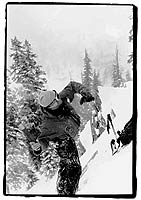Photo Essay: Good Morning Squaw Valley Part 2

And Greg Trinker
6:47 am
Randy Gottfried rises at 5:15 am in order to land on the High Camp deck by 6:30 am. With Squaw averaging 450 inches of snow annually, someone has to dig out the snowblowers before the snowblowers can dig out everyone else. That someone would be Randy.
6:56 am
Patrollers drop 3-pound charges 500 feet onto the 30-degree North Wall of Broken Arrow to trigger a controlled slide. On avalanche days, snow control starts early: Ski Patrol Director Bob Cushman arrives at 2:45 am to collect data from three on-mountain weather stations and then devises a bombing strategy with forecaster Russ Johnson. Up to 30 patrollers are dispatched over Squaw’s sprawling mountain to initiate slides. Like a modern-day army, patrollers would rather wage an air war from a safe distance than battle snow hand-to-hand in the trenches.
7:11 am
After igniting the water-resistant fuse, Steve Hurt has 90 seconds to toss a bomb in a way that would make Nolan Ryan proud. Hand-propelled bombs-14 inches long and containing 2.2 pounds of TNT (or its equivalent)-are hurled at least 100 feet. Squaw’s patrollers must pass a “blaster’s” test after three years of training with a leader (who has already earned his California Blaster’s License), because when you’re a professional avalanche controller, your first mistake can be your last.
Photo Essay: Good Morning Squaw Valley Part 1
Photo Essay: Good Morning Squaw Valley Part 3